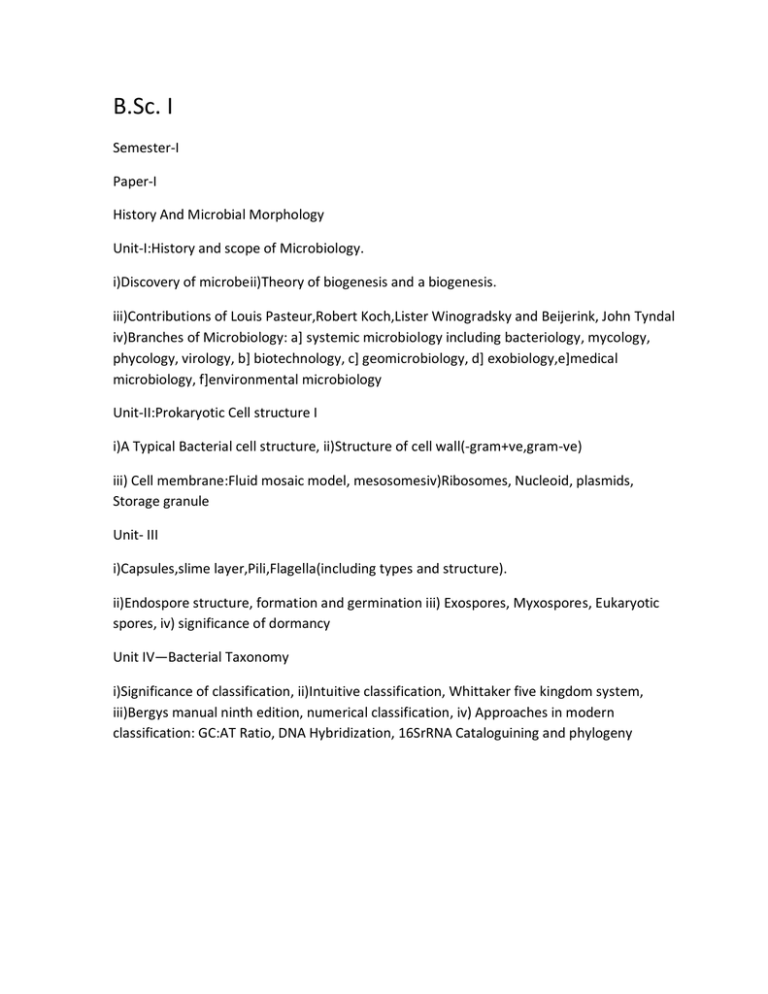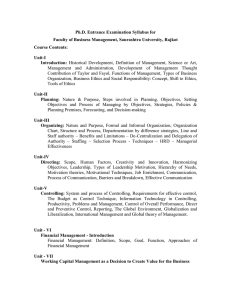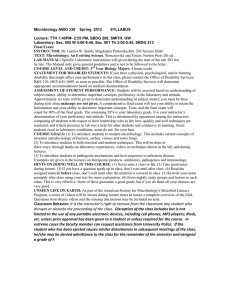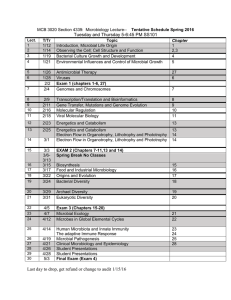B.Sc. I
advertisement

B.Sc. I Semester-I Paper-I History And Microbial Morphology Unit-I:History and scope of Microbiology. i)Discovery of microbeii)Theory of biogenesis and a biogenesis. iii)Contributions of Louis Pasteur,Robert Koch,Lister Winogradsky and Beijerink, John Tyndal iv)Branches of Microbiology: a] systemic microbiology including bacteriology, mycology, phycology, virology, b] biotechnology, c] geomicrobiology, d] exobiology,e]medical microbiology, f]environmental microbiology Unit-II:Prokaryotic Cell structure I i)A Typical Bacterial cell structure, ii)Structure of cell wall(-gram+ve,gram-ve) iii) Cell membrane:Fluid mosaic model, mesosomesiv)Ribosomes, Nucleoid, plasmids, Storage granule Unit- III i)Capsules,slime layer,Pili,Flagella(including types and structure). ii)Endospore structure, formation and germination iii) Exospores, Myxospores, Eukaryotic spores, iv) significance of dormancy Unit IV—Bacterial Taxonomy i)Significance of classification, ii)Intuitive classification, Whittaker five kingdom system, iii)Bergys manual ninth edition, numerical classification, iv) Approaches in modern classification: GC:AT Ratio, DNA Hybridization, 16SrRNA Cataloguining and phylogeny Paper-II-Microbial Diversity. Unit-I:Prokaryotic microbes i)General characters of a)Proteobacteria, b)Mycoplasma, c)Rickettsia and chlamydia ii)Cyanobacteria: Study of anabena and applications of cyanobacteria iii)Actinomycetes: Streptomysis and their applications iv)Archaebacteria: Methanogenic bacteria and their importance Unit-II:Eukaryotic microbes i)Fungi and yeast:Generalcharacters,Asexual and sexual mode of reproduction,slide culture techniques. ii)Algae:-General characters and industrially important algal cells iii)Protozoans: General characters and life cycle of trypanosome iv)Differences between prokaryotes and eukaryotes Unit-III:Acellularmicrobes:Viruses. i)Discovery of viruses, General structure, symmetry and classification ii)Cultivation,chickembryo,tissue culture iii) Detection of viral growth iv)T4-Bacteriophages,lytic cycle, Lysogeny and Lambdaviruses. Unit-IV:Microbial interaction. i)Positive and negative interaction:Commensalism, synergism, syntropism, mutualism, parasitism, predation, antagonism, competetion ii)Protist-ProtistInteraction:Bdellovibrio iii)Protist-Plant interaction: Root nodule bacteria iv)Protist-Animal interaction: Rumen bacteria, insect midgut bacteria, luminescent bacteria Semester-II Paper-I-Microbial Physiology Unit-I:Microbial Nutrition. i)Nutritional types of bacteria.ii)Basic nutritional requirements. iii)Types of culture media,growth,selective,enriched,enrichment,synthetic non synthetic. iv)Axenic cultures.Diauxic cultures. Unit-II:Microbial growth and cell cycle. i)Bacterial cell cycle ii)Principle of growth curve and mathematical expression. iii)Continuous culture: Turbidostat and chemostat. iv)Factors influencing microbial growth. Unit-III:Microbial control. i)Concept of microbial death ii)General terms:microbiostatic,cidal disinfectant,sanitizer. iii)Ideal antimicrobial agents. iv)Physical methods;a)Heat and moist sterilization.b)Dry sterilization, c)Low temperature. d)Filtration, e)radiation, f)osmotic pressure. Unit-IV:Chemical agents i) Phenolics, Alcohols, Halogens, Heavy metals, Quaternary ammonium compounds, Bignamides-Chlorohexidines, Surface active agents, Aldehydes b)Gaseous sterilization c)Chemotherapeutic agents i)Mechanism of cell injury. ii)Factors influencing antibiotic activity d)Phenol coefficient Semester-II Paper-II-Microbial Techniques Unit-I:Microscopy-I Principle and application i)Bright field microscopy, ii) Dark field microscopy, iii)Electron Microscopy(TEM, SEM), iv)Confocal microscopy. Unit-II: Microscopy- II-Principle and applications i)Atomic Force Microscopy ii)Phase contrast microscopy.iii)Fluorescent microscopy. Unit-III- Staining techniques i) Stains and dyes,chromophore,auxochrome,chromogens,types of stains. ii) Staining techniques:simple,differential,gram staining,acid fast staining. iii) Staining of specific structure: flagella, spores, capsule (negative) iv) Theory of staining Unit-IV:Nutritional and growth techniques. i)Isolation of pure culture:various techniques. ii)Determination of C N P etc. by auxeno graphic and replica plate technique iii)Synchronous culture techniques.iv)Measurement of growth. PracticalsSemI 1.General concept of basic equipments and apparatus 2.Preparation of media and stains 3.Isolation of microbes from air, water, soil 4. Performance of simple Grams, acidfast and spores staining 5.Isolation of pure culture 6. Performance of slide culture technique and fungal staining 7. Performance of antibiosis 8. Performance of motility PracticalsSem II 1. 2. 3. 4. 5. 6. 7. 8. Enumeration of microbes by SPC method Performance of oligodyanamic action Determination of phenol coefficient Study the effect of salt on growth To perform membrane filtration To demonstrate the effect of radiation To cultivate anaerobic bacteria Demonstration of Micrometry B.Sc. II Semester III Paper I Chemistry of Organic Constituents And Enzymology Unit I—Carbohydrates And Lipids Classification of carbohydrates ,Structure of glucose, fructose, maltose, lactose, sucrose, raffinose, starch, hyaluronic acid, glycogen, cellulose, osazone formation Classification of lipids, structure of triglyceride, compound lipids, derived lipids Unit II---Amino acids and proteins Classification of amino acids, titration curve, acidic, basic and neutral amino acids, peptide bond theory, organizational levels of proteins, concept of oligomeric protein UnitIII--- Enzymology Definitions and nature of enzymes, classification, nomenclature, primary concept of enzyme kinetics, MM equation, modifications of MM equations, activation energy, transition state, ES complex, enzyme activity, katal,specific activity, turn over number Enzyme inhibition and their types, enzyme regulation, their types, allosteric sites, allosteric modulaters, functional diversity such as holoenzyme, apoenzyme, coenzyme, cofactor, prosthetic group, isoenzymes, membrane bound enzymes, multienzyme complex, zymogens Unit IV---Nucleic acid and Vitamins Structure of purines, pyrimidines, nucleosides, nucleotides, DNA, RNA, and various forms of DNA Types of vitamins, Classification on the basis of solubility, functions of vitamins, Hyper and hypovitaminosis B.Sc. II Semester III Paper II Industrial Microbiology Unit I---Fundamentals of industrial microbiology Definition and scope of industrial microbiology, general concept, primary screening,secondary screening, strain development, sterilization of fermentors, production of media and air Unit II---Fermentor design Types of fermentation processes, design of typical fermentor, parts of fermentor, factors effecting fermentor design, control of agitation,aeration, pH anddissolved oxygen, types of fermentors Unit III ---scale up and DSP Inoculum development, scale up of fermentor process, raw media for media preparation, Harvesting and product recovery Unit IV ---Industrial Production Production, biochemistry, recovery and uses of: SCP, Bakers yeast, ethanol, penicillin, semisynthetic penicillin, citric acid, Vit B12 and beer and wine B.Sc. II Semester IV Paper I Metabolism Unit I---Carbohydrate General strategy of metabolism, EMP pathway and its regulation, TCA cycle and its regulation, Outline of ED pathway, Pentose Phosphate pathway, PK pathway Unit II---Lipid and Nucleic Acid Betaoxidation, Omegaoxidation, Replication of DNA, modes of replication, general features, enzymes involved, rolling circle and knife and fork model, Prokaryotic transcription including general features, enzymes involved and reverse transcription Unit III---Amino acids and Proteins Amino acid breakdown, deamination,(alanine, tyrosine, metionone) urea cycle, metabolic breakdown of individual amino acids, glucogenic and ketogenic amino acids Genetic code and Prokaryotic translation Unit IV---Energy Generation High energy molecules, substrate level phosphorylation, Cyclic and noncyclic photophosphorylation, Oxidative phosphorylation and ATP generation B.Sc. II Semester IV Paper II Applied Microbiology Unit I ---Water microbiology Significance of bacteriological analysis of water, collection and handling of water samples, indicators of excretal pollution, bacteriological analysis of water for coliforms and faecal streptococci (MTFT, MFT), water treatment using SSF and RSF,methods of chlorination, differences between fecal and non fecal organisms Unit II---Waste water treatment Sewage types, composition, physical, chemical and biological characteristics, BOD, COD, ThOD, trickling filter,activated sludge, RBC, sludg digester, oxidation pond, septic tank, imhoff tank Unit III--- Air and Soil microbiology Microbial analysis of air , settling plate and Anderson technique, bacteria and fungi as biopesticides, biofertilizers, PSB, mycorrhiza, microbial leaching of copper and uranium Unit IV --- Food microbiology Food spoilage organisms, canning process, pasteurization, low temperature preservation, chemical preservation Food borne diseases and food intoxication Practicals Semester III 1. 2. 3. 4. 5. 6. 7. Identification of carbohydrates and lipids Detection of enzymes: amylase, catalase, gelatinase, lipase Estimation of proteins Estimation of DNA Estimation of RNA Production and estimation of alcohol Isolation of amylase producer from soil 8. Leavening capacity of yeast 9. Immobilization of yeast and demonstration of invertase activity PracticalsSem IV 1Isolation of organisms from water and sewage 2Determination of MPN 3IMViC Test 4Determination of DO, alcalinity 5MBRT, Phosphatase test 6,BOD and COD 7 Detection of arsenic by bioassay 8 determination of Chlorine demand B.Sc.Final SemesterV Paper-I Medical microbiology Unit-I Epidemiology and host –parasite relationship. a) Definitions: i)Signs,symptoms and syndrome of disease,stages of infectious diseases-incubation period,prodromalphase,Invasivephase,decline phase and the period of convalescene,primaryinfection,secondaryinfection,acuteinfection,chronic infection local and systemic infection. ii)Bacteremia,septicaemia,pyamia,toxemia,Viremia. iii)Epidemic,Endemic,Pandemic,Zoonotic,Exotic. b)Dynamics of disease transmission: i)Causative or etiological agents[list] ii)sources of reservoir of infection. .Exogenous Human (case and carrier) Non-living reservoir. Endogenous infections. iii)Portal of exit iv)Mode of transmission-Contact, laboratory/hospital infections. Vehicle,Vector,Air-borne,transplacental and v)Portal of entry. vi)Susceptibility of host. c)control of communicable diseases: Control of sources, blocking the channels of transmission,protecting the susceptible host. Unit-II a)Microbial mechanism of Pathogenicity: pathogenicity and virulence,exaltation and attenuation,MID,MLD,ID 50,LD50. i)Invasiveness:-adherence,capsule,enzymes. ii)Toxigenicity:-Exotoxins and Endotoxins. b)Normal flora of healthy human host: Definition,originsignificance,Germ free and Gnotobiotic life. Characteristics of normal flora.. c)Infectious microbiology: Microbial diseases of skin, eye,digestive, respiratory,cardiovascular,lymphatic,urinary,reproductive and nervous systems. (outline of structure of each system and lists of infectious diseases affecting the particular system). Unit-III Study of pathogenic organisms: Morphology, cultural characteristics, biochemical characteristics, serology, lab diagnosis 1.Bacteria: .Salmonella typhi and paratyphi A & B. .Mycobacterium tuberculosis. .Spirochetes-treponemmapallidum 2.Viruses: .HIV .Hepatitis A & B 3.Protozoa: .Plasmodium Unit-IV Disease control: Basic principle of drug designing. Development of modern drug delivery system. Basic mechanism of action of drugs. Bacterial cell wall synthesis inhibitor; Penicillin Bacterial protein synthesis inhibitor: chloramphenicol Bacterial DNA synthesis inhibitor:Nalidixic acid,Floxacin antibiotics. Antimetabolites:Trimethoprime,sulfamethoxazole. Non automated and automated in vitro drug susceptibility testing-kirby-Bauer disc diffusion method and e-strip method. Reasons for development of resistance Semester V Paper-II Molecular biology and bioinstrumentation Unit-I Gene mutation and regulation. a)Concept of gene,muton,recon,cistron,monocistronic and polycistronicgene,gene within gene,spit gene. b)Gene regulation:lac operon(detail) c)mutation:Definition,randomvs directed mutation,type of mutation,base substitution,frameshift,point,nonsense,missense,and silent mutation. d)Genetic suppression:Intergenic and Intragenic. e)Molecular basis of mutation:Mechanism of spontaneous and induced mutation. Unit-II Genetic recombination: a)Definition,Basic concept of recombination b)General types of recombination. c)Transformation. d)Conjugation e)Transductions f)Transposable genetic elements(Prokaryotic) pair Unit-III Bioinstrumentation-I( Principles and applications) a)Spectroscopy:Laws of absorption,limitations of beer law,UV-Visible spectroscopy and its applications. b)Centrifugation:Type of centrifuge,analytical and ultra centrifugation,density gradient centrifugation. c)Electrophoresis:Principle,types of electrophoresis,agarose gel electrophoresis and SDSPAGE. Unit-IV Bioinstrumentation-II( Principles and applications) a)Chromatography:Thin layer chromatography, ion exchange, gel filtration, HPLC b)Isotope tracer technique:Method and applications. Detection and measurement of stable isotope:Mass spectrometry. Detection and measurement of radioactive isotope:GM counter,scintillation counter. B.Sc. Final Semester VI Paper-I Immunology Unit-I: Defensive mechanism of host: a)Nonspecificdefences of the host: i)species,race and Individual resistance. ii)age,sex,hormonal and nutritional influences. iii)Mechanism of non-specific defences: I.First line of defence:Skin,mucusmembrane,Mechanical chemical and microbial defences. II.Second line of defence:Phagocytosis,inflammation,fever,interferon,complement system. b)Acquired immunity: Active and Passive immunity. c)Organs involved in immune function: 1.Primary lymphoid organs:Bursa,bonemarrow,thymus. 2.Secondary lymphoid organs:Lymph nodes, Spleen,MALT,GALT,CALT. Unit-II: a)Diagram of Haematopoiesis. b)Cells of immune system: general characters of 1)B and T cells, 2)Monocytes and macrophages, 3)Neutrophils,Eosinophils and basophiles. 4)Mast cells 5)Dendritic cells 6)Natural Killer cells. c)B-cell biology:(Humoral immunity) 1.Primary and secondary immune response 2.Clonal selection and clonal deletion(immune tolerance) 3.T-cell dependent antibody response.outline 4.T-cell independent antibody response.outline d)T-cell biology:(Cell mediated immunity) 1.Types of T-cells and Cluster of differentiation(CD) 2.T-cell receptor(TCR) 3.Cytotoxic T-cell response 4.MHC molecules and antigen presentation.(diagrammatic) 5.Cytokines-Definition,types(colony stimulating factor,Interleukins,Tumor necrosis factor alpha). Unit-III: a)Antigens: I)Definition,Completeantigen,hapten,epitope,valence. II)Factors determining antigenicity III)Antigenic mosaic of bacteria IV)Antigens in relation to human being:Speciesspecific,isoantigen,autoantigen(RA),Organ specific antigens,Heterophile antigens. b)Antibody: I.Definition,General structure. II.Classes of Immunoglobulins and their functions. c)Ag-Ab reactions(Diagnostic immunology) I.General features of antigen-antibody reactions. II. Antibody titre,rising antibody titre,paired sera III.Precipitation:Precipitation in liquids,Immunodiffusion,Immunoelectrophoresis. IV.Agglutination: agglutination,tubeagglutination,haemagglutination,Haemagglutination test,coomb’stest,passive agglutination. Slide inhibition UNIT IV a) Tagged antibody test: ELISA direct and indirect b) Immunofluroscence c)Hypersensitivityreactions:Definition,Gel&Coomb’s classification. 1.Type I (Anaphylaxis) Hypersensitivity:Mechanism of anaphylaxis,systemic and localized anaphylaxix,prevention of anaphylaxis. 2.Type II (Cytotoxic) Hypersensitivity: .Blood transfusion reaction(Rh compatibility) .Heamolytic diseases of the new borne 3.Type III (Immune complex)hypersensitive: .Arthus reaction .Serum sickness. 4.Type IV(delayed)Hypersensitivity: Mantaux test, allergic contact dermatitis. Semester VI Paper II Biotechnology Unit I: Tools & techniques of genetic engineering: a)Preparation of pure samples of DNA,range of enzymes used in DNA manipulation,analysis of DNA fragment size,Joining of DNA molecule,vectors and their types. b)IntroducingrDNA into host cell,transformation of cells,identification of transformed cells,selection of clones,direct and indirect method. c)Expression of cloned genes,construction of gene library,cells for cloning,expression of prokaryotic genes. d)PCR and its application,DNA fingerprinting. Unit-II:Application of genetic engineering: a)Health Biotechnology: i)Production of hormones:insulin ii)Production of interferon. iii)Production of vaccines:Conventionalvaccines:BCG,salk,Diphtheriatoxoid,ATS,DNAvaccines,Edible vaccines. iv)Hybridomatechnology,monoclonal antibody formation Unit-III b)Agricultural biotechnology: i)Protoplast fusion ii)Biopesticides. iii)Biofertilizers c)Industrial biotechnology i)Bio sensor and Nano biotechnology applications ii)Biochips and concept of microarray. d)Ethics and hazards of biotechnology. Unit-IV Food 1)Genetically modified food.definition and one example 2)Oriental Fermented food:soyasauce,miso,sufu 3)Transgenic plants.BT Cotton 4)Transgenic animals and clones: Knockout mice, Dollyship, Milching animals Practicals Semester v 1) 2) 3) 4) 5) 6) 7) 8) Isolation of bacterial DNA Isolation of plasmid DNA Demonstration of restriction digestion Estimation of creatinine by spectrophotometric method Perform gelfiltration Perform paper chromatography Perform TLC Identification of bacteria: E coli, S aureus, Salmonella, Proteus Practicals Semester VI 1) 2) 3) 4) 5) 6) 7) 8) Perform VDRL test Perform Widal test Perform immunodffusion Perform Western blot Perform PCR Development of sphaeroplast Production of biofertilizer Production of soyasauce





